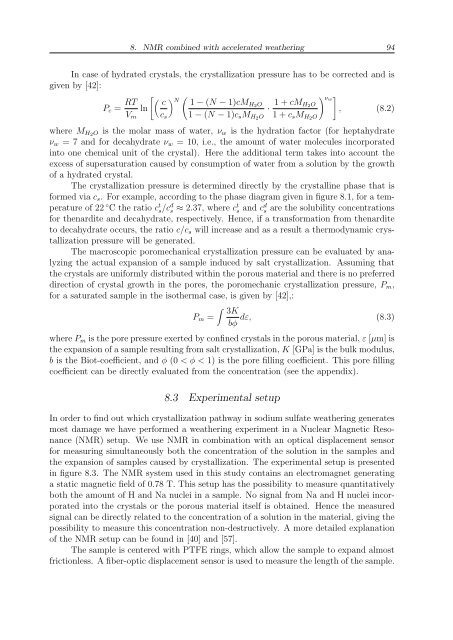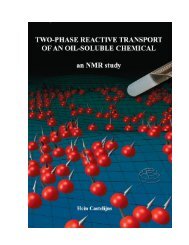P - Technische Universiteit Eindhoven
P - Technische Universiteit Eindhoven
P - Technische Universiteit Eindhoven
Create successful ePaper yourself
Turn your PDF publications into a flip-book with our unique Google optimized e-Paper software.
8. NMR combined with accelerated weathering 94<br />
In case of hydrated crystals, the crystallization pressure has to be corrected and is<br />
given by [42]:<br />
P c = RT [ ( ) ( c N 1 − (N − 1)cMH2 O<br />
ln<br />
· 1 + cM ) νw<br />
]<br />
H 2 O<br />
, (8.2)<br />
V m c s 1 − (N − 1)c s M H2 O 1 + c s M H2 O<br />
where M H2 O is the molar mass of water, ν w is the hydration factor (for heptahydrate<br />
ν w = 7 and for decahydrate ν w = 10, i.e., the amount of water molecules incorporated<br />
into one chemical unit of the crystal). Here the additional term takes into account the<br />
excess of supersaturation caused by consumption of water from a solution by the growth<br />
of a hydrated crystal.<br />
The crystallization pressure is determined directly by the crystalline phase that is<br />
formed via c s . For example, according to the phase diagram given in figure 8.1, for a temperature<br />
of 22 ◦ C the ratio c t s/c d s ≈ 2.37, where c t s and c d s are the solubility concentrations<br />
for thenardite and decahydrate, respectively. Hence, if a transformation from thenardite<br />
to decahydrate occurs, the ratio c/c s will increase and as a result a thermodynamic crystallization<br />
pressure will be generated.<br />
The macroscopic poromechanical crystallization pressure can be evaluated by analyzing<br />
the actual expansion of a sample induced by salt crystallization. Assuming that<br />
the crystals are uniformly distributed within the porous material and there is no preferred<br />
direction of crystal growth in the pores, the poromechanic crystallization pressure, P m ,<br />
for a saturated sample in the isothermal case, is given by [42],:<br />
∫<br />
P m =<br />
3K<br />
dε, (8.3)<br />
bϕ<br />
where P m is the pore pressure exerted by confined crystals in the porous material, ε [µm] is<br />
the expansion of a sample resulting from salt crystallization, K [GPa] is the bulk modulus,<br />
b is the Biot-coefficient, and ϕ (0 < ϕ < 1) is the pore filling coefficient. This pore filling<br />
coefficient can be directly evaluated from the concentration (see the appendix).<br />
8.3 Experimental setup<br />
In order to find out which crystallization pathway in sodium sulfate weathering generates<br />
most damage we have performed a weathering experiment in a Nuclear Magnetic Resonance<br />
(NMR) setup. We use NMR in combination with an optical displacement sensor<br />
for measuring simultaneously both the concentration of the solution in the samples and<br />
the expansion of samples caused by crystallization. The experimental setup is presented<br />
in figure 8.3. The NMR system used in this study contains an electromagnet generating<br />
a static magnetic field of 0.78 T. This setup has the possibility to measure quantitatively<br />
both the amount of H and Na nuclei in a sample. No signal from Na and H nuclei incorporated<br />
into the crystals or the porous material itself is obtained. Hence the measured<br />
signal can be directly related to the concentration of a solution in the material, giving the<br />
possibility to measure this concentration non-destructively. A more detailed explanation<br />
of the NMR setup can be found in [40] and [57].<br />
The sample is centered with PTFE rings, which allow the sample to expand almost<br />
frictionless. A fiber-optic displacement sensor is used to measure the length of the sample.
















